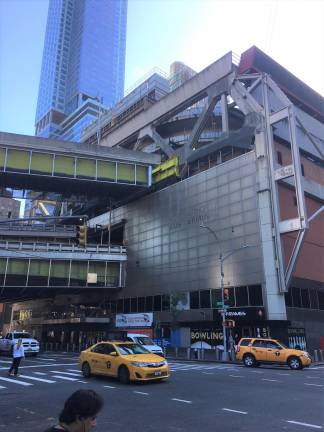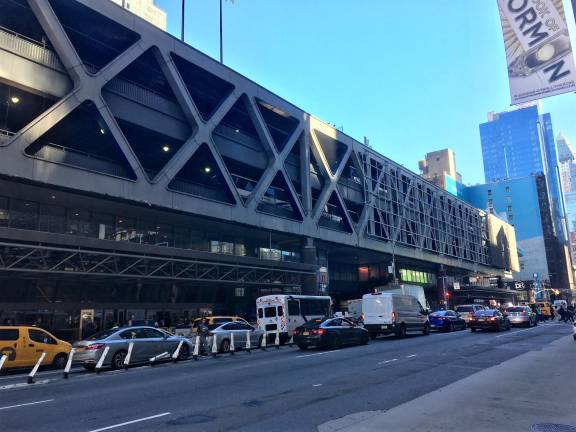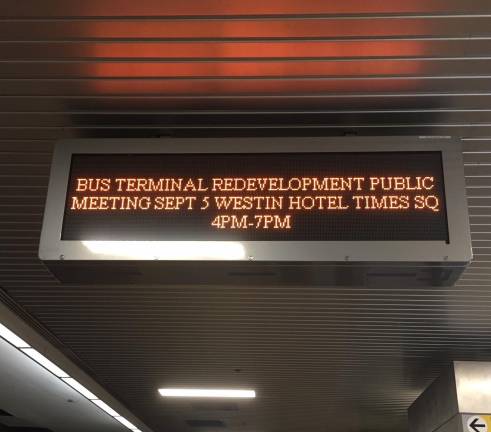Public Hearing on Port Authority Bus Terminal Plans
The future of the 69-year-old facility will be the only topic at the mandated session



New Yorkers will get to weigh in this week on a trio of options for the transformation of the Port Authority Bus Terminal (PABT), the nation’s largest bus terminal. On Thursday, the Port Authority of New York and New Jersey will hold a hearing at the Westin Hotel Times Square, at 270 West 43rd St., between Seventh and Eighth Aves. There will be presentations at 4:30 p.m. and 6 p.m. A meeting will also take place in New Jersey.
The Manhattan hearing falls within the Port Authority’s 120-day period to solicit comment from the public. The first two such meetings, one in each state, were held July 10. The deadline for public comment is Sept. 18.
The project, which is expected to cost $7.5 to $10 billion, is anticipated to be finished by 2030.
The goal is to address capacity constraints and operational limitations of the existing facility, and to improve bus storage and staging to reduce bus idling, on-street congestion and improve bus network reliability.
The existing terminal was built in 1950 and expanded in 1981. The terminal now serves an estimated 260,000 passenger trips on weekdays, or 23 percent of trans-Hudson trips entering or exiting Manhattan’s central business district, and 8,000 bus movements. Demand is expected to increase by 30 percent, with up to 337,000 weekday passenger trips by 2040.
In May, the Port Authority released a planning-level scoping document for public review and comment as part of the environmental review process. According to the scoping document, there are three options in play for the bus terminal, which stretches from West 40th to West 42nd Street, between Eighth and Ninth Avenues.
Repair and operate the terminal at the same time.
This option would maintain connectivity to the Lincoln Tunnel in essentially the present configuration; the addition of a new Ninth Avenue underpass would provide direct connection from the Lower Level to the Lincoln Tunnel network to improve trans-Hudson bus operations.
It also provides direct accessibility for passengers with the existing subway, totaling 12 lines. Furthermore, this alternative would provide an Americans with Disabilities Act (ADA) compliant facility and accommodate modern day bus design, while providing more efficient circulation. The Build-in-Place Alternative includes the potential development of a portion of the PABT site for private commercial development.
Convert the lower level of the Jacob Javits Convention Center into a bus terminal.
Storage and staging as well as intercity bus operations could be provided in the Javits lower level for this alternative. Additionally, this option includes the potential private commercial development of the existing PABT site.
This alternative would be challenging from a design and construction perspective due to the following factors: Proposed Lincoln Tunnel extensions would be problematic as they would require the likely shutdown of lanes and full tunnel tubes.
The construction would also violate the “grandfathered” status of the Lincoln Tunnel’s existing ventilation system; require significant investment in replacing the system.
Construction would require the raising of the Westside Highway, which would also likely require shoring and underpinning of a highway that is the only major capacity roadway on the west side of Manhattan. Development would occur on an existing pier, which would require additional in-water construction and extensive permitting actions.
This alternative, at a minimum, requires the approval of the New York Convention Center Operating Corporation (NYCCOC).
Relocate some bus operations to the lower level of the Javits center
Storage and staging as well as intercity bus operations would be provided in the lower level of the existing Javits Center for this alternative.
The alternative assumes commuter buses would continue to use a newly renovated (as opposed to reconstructed) PABT facility; thus there is no opportunity for potential development on the existing PABT site.
The viability of this assumed renovation appears problematic and potentially impracticable due to the inability to achieve or address the following: Meeting Americans with Disabilities Act (ADA) requirements without reducing capacity. Accommodating heavier, taller, and longer buses. Incorporating new building, bus operation and passenger technologies. (eg. wayfinding, signage, ticketing) Providing the adequate amount of passenger queuing space at gates and within the facility. Accommodating more flexible floor plate and a more efficient gate configuration.
This alternative requires the approval of the New York Convention Center Operating Corporation (NYCCOC), at a minimum.
“We are committed to building the replacement Bus Terminal and to do so in full consultation with the community, with elected officials in both New York and New Jersey, and with all stakeholders,” said Port Authority Executive Director Rick Cotton in a statement in May.
In the Meantime
While the process to build a new bus terminal is continuing, the Port Authority has undertaken an aggressive $110 million Quality of Commute program to enhance the customer experience at the existing facility. The initiatives include new and enhanced retail, new bathrooms, new doors at the terminal’s Eighth Avenue entrance, new lighting and ceiling and improved elevators and escalators. The Port Authority also has partnered with bus operators on operational changes that have reduced crowding within the terminal and relieved congestion caused by buses on nearby streets.
The growth in bus demand to the PABT facility and passenger activity at the bus terminal has been growing rapidly. Regional forecasts from the Metropolitan Planning Organizations (MPO)—New York Metropolitan Transportation Council’s Best Practices Model (NYMTC BPM) and the North Jersey Transportation Planning Authority’s (NJTPA) North Jersey Regional Transportation Model (NJRTM), both from 2013, indicated that passenger activity at the PABT would rise to 337,000 per day (30 percent) by 2040.